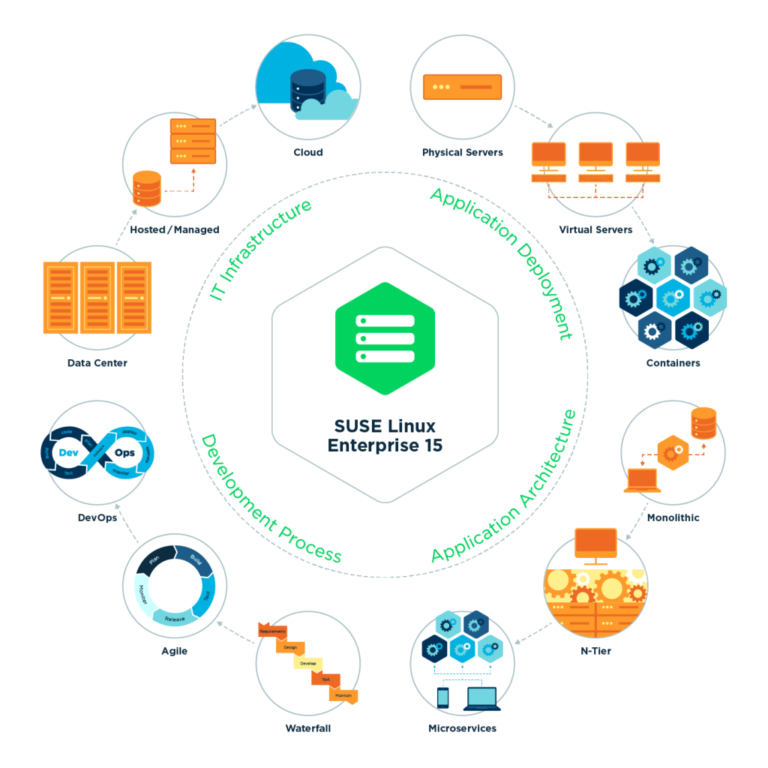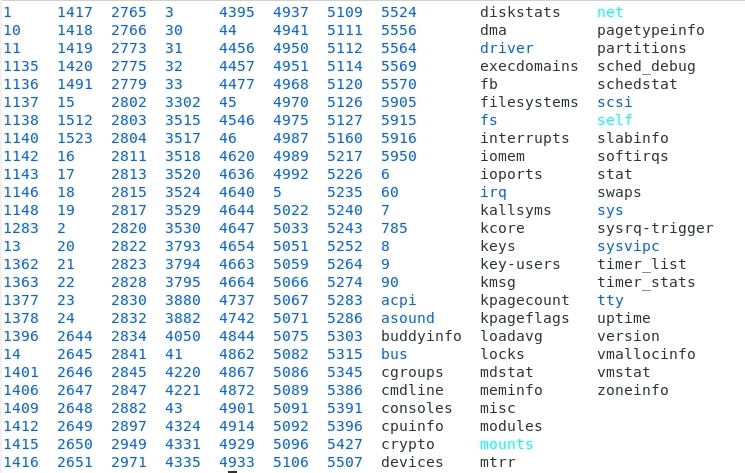This is a very subjective review of the MintBox 3. I say “very subjective” because not only do we get 5% of each sale (that in itself wouldn’t matter all that much), but we absolutely love this unit, the very long partnership we’ve had with Compulab and the fact that this amazing computer is running our software and wears our name.
No computer is perfect though, we’ll make some criticism, but as an introduction I’d rather warn you. This is by far the best computer we’ve ever played with, it runs Mint and it has our logo on it. It’s hard not to feel any bias 
Compulab Links
- Press release
- Specifications
- Gallery
First impression
The MintBox 3 has a very unique look. When you show it to people who aren’t into computers they often ask “What is it?”.
It’s relatively small. Here it is beside a book and a 13″ laptop:
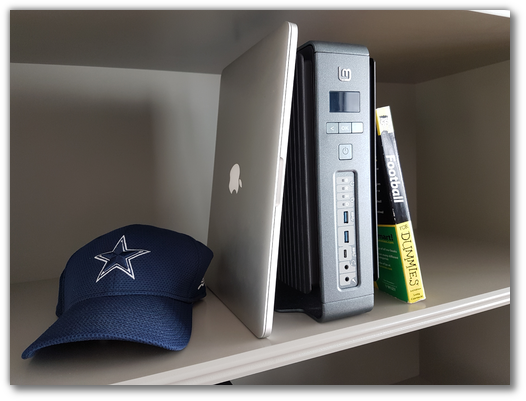
Don’t be fooled by the size though. The MintBox 3 isn’t light. It’s quite heavy in fact. I brought mine on a trip to France, with me in the luggage compartment. It fitted perfectly inside my little suitcase but it took a whole 7Kg out of the 10Kg I was allowed to carry with me. I didn’t have much left for my clothes 
The security at the airport wanted me to open it. That was easy to do… but more on that later.
The reason the MintBox 3 is so heavy is because it’s built entirely out of metal. The entire unit, its foot and the heat sinks are made of thick metal and because the computer is quite small it’s definitely heavier than it looks.
Looking at it from the front, the MintBox 3 has a bit of a Star Wars vibe. The massive metal heat sinks on both sides make it look like an Imperial Tie Fighter.
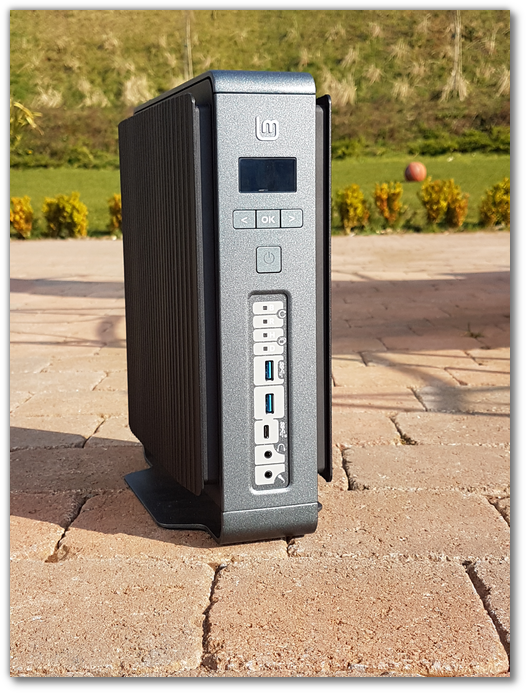
The Linux Mint logo is diamond cut and is part of the casing. The build quality is very impressive. It’s not common to see a computer using these materials and that level of finish.
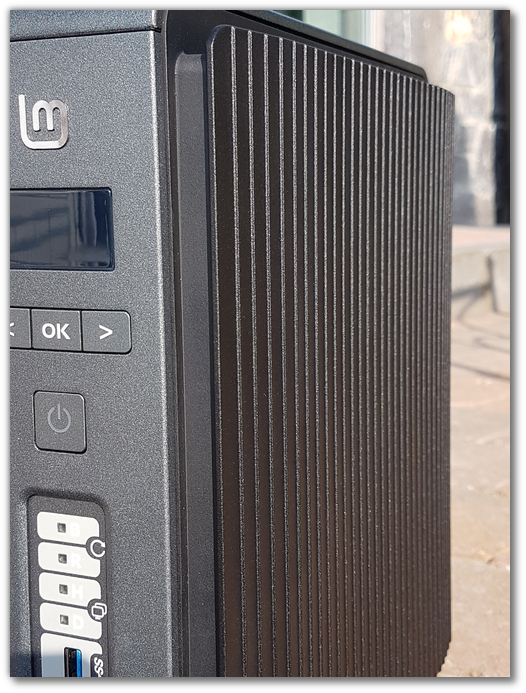
Although there are a few audio and USB3 ports in the front panel, it’s at the back that you find most of the connectivity. The MintBox 3 features plenty of ports and interfaces so connecting the unit to various displays, devices and networks isn’t an issue.
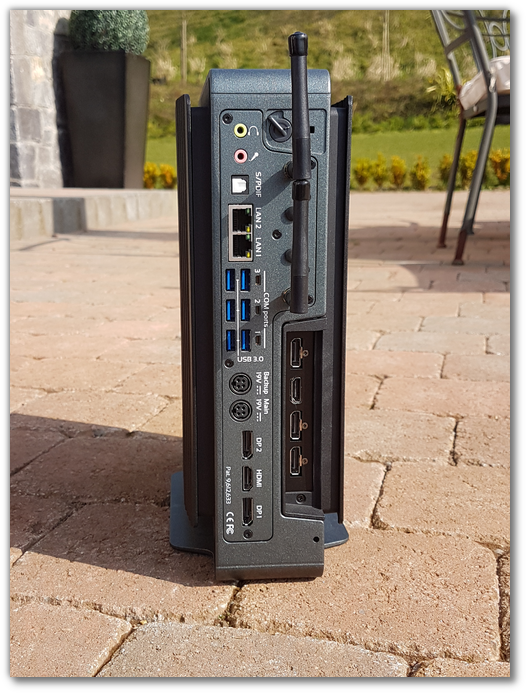
If you push the top of the unit, it opens the lid. There’s a little lock at the back to either prevent or allow this.
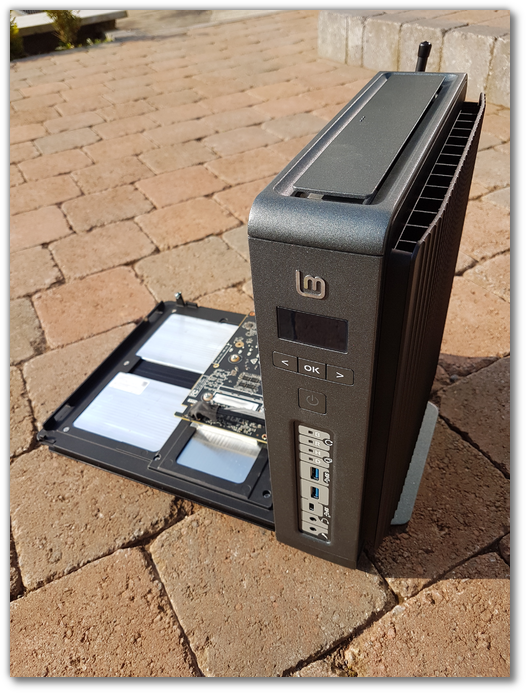
The NVIDIA graphics card is stuck against the inside of the lid to maximize its surface contact and thermal dissipation through the left heat sink.
There are no fans inside the MintBox 3, it’s a silent computer. The heat produced by the CPU and the GPU go through the two metal heat sinks on the sides of the unit.
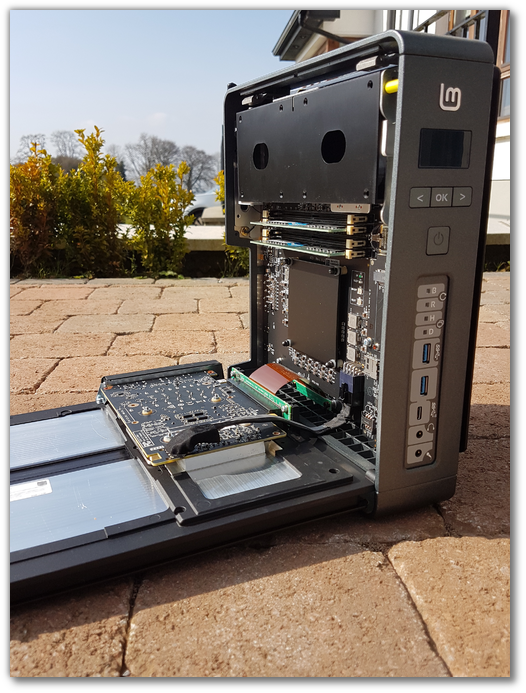
Inside the box, the components are neatly organized and easily accessible. It’s very easy to get to the RAM or to pull the lever to detach the storage bay, which on top of the NVMe drive attached to the motherboard, has room for 4 additional SSDs.
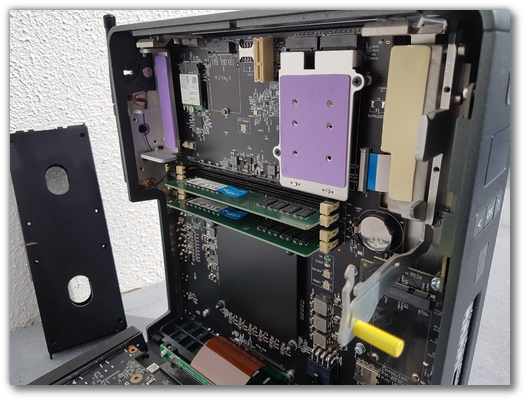
On the front panel, an LED screen shows the CPU and GPU temperatures in real time.

Specifications
The MintBox 3 Pro comes with 32GB RAM, an Intel i9-9900K CPU, an NVIDIA GTX 1660 Ti GPU and 1TB of NVMe storage.
It has 2 gigabit Ethernet ports and supports 802.11ac WiFi and Bluetooth 4.2 connections.
The NVIDIA card has 4 ports: 3 DisplayPort and 1 HDMI.
Developers thoughts
So far 4 other Mint developers received a MintBox 3. I’m hoping we’ll be able to send one to more people within the team as we go along.
Here are Michael’s thoughts on the MintBox 3:
It’s by far the nicest looking and working device I’ve ever used. It feels bulletproof, there’s more expandability than I expected.
Performance is great – I’m still adjusting to how long I’m used to things taking. Had some bothersome noise (high freq) initially, but that has disappeared almost entirely.
When asked what could be improved he replied:
I’d like to have the front panel display remember the page it’s on between reboots and it would be nice to be able to conceal the front I/O ports.
Stephen said:
My first impression after opening the box was “This thing is incredible!”. I was particularly impressed by how well built it is.
Everything is so efficient inside, it’s easy to open (not that I need to often) and it just looks different (in a good way). The heat sinks actually add to the overall look, rather than detracting from it. Between that, and how well everything fits together it really has a high-quality feel to it.
This is by far the fastest and most powerful PC I’ve ever used. Everything else feels slow in comparison. When I first started using it, it was eerily quiet too. Now that I’m used to it, every other PC seems noisy in comparison. There is a little bit of “coil noise” when the NVME is really active, but I hardly notice that any more.
Even though the “new car smell” has started to fade, I still love using it. It’s particularly nice when I’m doing something processor or hard drive intensive like running a software build, downloading a large file, or when I have to restart multiple times. It’s just so fast!
Stephen’s thoughts on potential improvements were:
The one downside I’ve seen so far is that the audio ports are a bit glitchy. Every time something engages the sound, I get this annoying popping sound as though the speakers are just turning on (even though they’ve been on the whole time).
Joseph said:
My first impression opening the box was how unique the design was. Also was surprised by how small, compact, and heavy it was. It was well packed in the box.
I like the look. It reminds a lot of the look of the old audio amplifiers I used to use in my vehicle. It’s also quite small. It’s pretty easy to access everything and just feels like a very well put together piece of hardware. I place it ON my desk and not underneath. It gets very hot where I live and I’m not sure if stuffing it in some small confined space under the desk would be the best.
The speed is amazing. Like everyone else, easily the fastest piece of hardware I’ve ever used. The way I have i set up, very close to me, the lack of fan noise is awesome but is a little strange at first. Not used to a machine that’s so quiet. It is not silent though. Quite a few clicking noises come out of it but they are very low level and I’m not sure I would even notice them if it didn’t set so close to me.
My overall impression of it hasn’t changed at all after using it for awhile. I switch around between a couple different machines so the speed of it still stands out every time I use it. The thing is just fast.
I will say the thing feels like a tank. If I dropped it on my wood floor, I think the floor is in more danger than the machine.
The clicking noises aren’t very loud. I just sit very close to it. It’s something I maybe just don’t notice in other machines because they are covered by fan noise.
When asked what could be better, he said:
I haven’t experienced any issues with it but I don’t really use the front ports. The one thing I would like to see improved some is the available documentation. One of the touted features is the ability to plug up to like 7 monitors into it. When trying to plug multiple monitors into it I was under the impression I could probably plug them into any port. That isn’t the case however. So I’m not sure if it requires plugging them into the ports in some certain order or combination or what. I could find zero info about this on their site for a feature that they push as one of the big things about it. To be fair, I didn’t try contacting customer support and just asking but I feel like it should be easier to find info for this.
Vincent’s impressions were:
I have a MintBox 2 so had some expectations. The MintBox 3 is larger and much heavier (for its size) than I had expected compared to the MintBox 2 but the build, fit & quality and finish are miles above anything I’ve seen or used before.
It looks and feels extremely high quality. Compared to a traditional desktop PC of equal power it is very small and much easier to pick up or transport. It stands very stable (doesn’t slide or tip) and everything is easily accessible. Packaging felt very secure. I’m not an immediate fan of the light grey highlights around the front panel ports—I would have preferred no highlighting so the front had a more uniform look. The logo is very cool but a bit understated perhaps; could have done with some green.
Realtek HD Audio
I believe the issue mentioned by Stephen is a temporary regression with the Linux kernel. We’ve a workaround for this (snd_hda_intel power_save=0), it affects many audio chipsets out there.
I’d like Realtek to improve the quality of their audio chipset though. They’re widely used in the industry and we can find Realtek HD Audio in many motherboards and computers on the market. The Internet is full of people trying to get the sound working in both their front and rear audio jack. In Linux we’re currently able to choose which jack is active but we can’t get both at the same time. In Windows, the sound can randomly switch from one jack to the next, back and forth.. and the option to control that is gone from Realtek’s latest drivers.
It only costs $7 to solve the problem with a USB sound card, but it’s a pity these kind of issues are still occurring with a company that’s been around for so long.
Speed and performance
Put simply, it’s the fastest computer I’ve ever used. My main computer was an Airtop 1 (also from Compulab, same casing, different specification) and it almost feels sluggish in comparison.
It’s going to sound silly… but one of my worries when I powered it for the first time was that there would be performance related bugs in Cinnamon I’d no longer be able to reproduce.
Out of the box, the MintBox 3 comes with Linux Mint 19.3 Cinnamon installed in OEM mode. The NVIDIA drivers and the drivers for the LED panel are already installed. Needless to say, the computer has no issue running any of that. To properly test the MintBox 3, I had to try to push it to its limits and so I went and got the heaviest and slowest operating system available on the market: Microsoft Windows.
With the help of Windows 10, an Oculus Rift S and the iRacing sim-racing game, I finally managed to put the MintBox 3 out of its comfort zone. I set all the game settings to max and I found some of its limits. I wouldn’t normally do that with a normal computer, but since that computer put the bar so high, I wanted to see how far it could get as a high-end gaming computer. Other than gaming or 3D rendering, I wasn’t quite sure how I’d manage to challenge it.
I found the CPU and GPU combination to be extremely powerful. When pushing everything to the max the limiting factor was the GPU heat. In 60Hz, it was able to render the game with almost any in-game settings, but if you asked too much of it, the temperature could get close to 90C, at which stage the NVIDIA card would cut the signal to the HDMI port.
I found that NVIDIA HDMI port to be sensitive to high frequencies also. It didn’t like pushing signals at 120 FPS. I don’t know if it’s a limitation of the GTX 1660 Ti, if it’s due to heat dissipation or if it’s a decision made by NVIDIA. In any case it only affects the HDMI port. The DisplayPort continues to work without any issues at these temperatures and at 120Hz.
The Oculus Rift S comes with its own built-in resolution (1280×1440 in each eye at 80FPS). It’s more demanding than playing on the screen, HDR had to be turned off and a few settings disabled, and then the MintBox 3 was able to accommodate the VR headset without any problems.
The way the MintBox 3 is built is a compromise and a contradiction by itself. It’s trying to be as powerful as possible, but within a form-factor that limits how much heat it can produce. When I try to push it to perform as a high-end gaming machine, I’m asking it to do something it’s not designed for. Yet, it does it admirably well.
A high-end gaming rig would be designed primarily for power, to push settings to the max, so the last things it would worry about would be the size and the build of the unit.
My overall impression on the performance of the MintBox 3 is that it’s overpowered. It has so much power in there I’m not sure we’ll ever use it… and when asked to do things completely over the top (like playing a sim in VR with HDR and max settings) it bottlenecks on heat more so than on performance.
I guess it just adds to the longevity of the machine. 32GB RAM, an i9 might look like a lot today but not so much in 5 or 10 years time. This is a really powerful machine. It’s not optimized for gaming but it does gaming pretty well too.
Passive cooling and coil whine
Like its predecessors the MintBox 3 is passively cooled. The heat produced by the CPU and the GPU are dissipated by the metal heat sinks. There are no fans inside the unit.
The MintBox, the MintBox 2, the MintBox Mini Pro 2, and the Airtop 1 were completely silent. When I say completely silent, I mean so silent that if you closed your eyes you couldn’t even tell if they were powered ON or not. In fact the Airtop 1 had a little issue with its power button LED, so it actually made a tiny little static noise when it was powered OFF (yes, that’s right, it made more noise when it was turned OFF than when it was running).
After using a passively-cooled computer for a while, anything with a fan sounds like a mini hoover. A typical desktop computer would come with a CPU fan, a couple of GPU fans and large case fans to evacuate the hot air, producing a constant humming noise, and over time, with dust, movement and impacts some of these fans could make a lot of noise.
Passive-cooling is amazing, especially if you live in the country side or if you work in a quiet environment.
The MintBox 3 is passively cooled and it is silent, but it isn’t “completely” silent. This is my main issue with this computer and if I had to change anything in it, that would be it. The components which come in the Pro model (i9 and GTX 1660 Ti) are extremely powerful and they produce what we call “coil whine”. These are high-pitched electronic squeaking or scratching noises. How noticeable and distracting they are largely depends on how silent your environment is. If you’re not familiar with coil whine, it sounds a bit similar to how HDDs sounded in the past, when they had these little noises coming from moving the read/write arm inside the hard drive. It’s not loud, it’s nowhere near as loud as a fan, but it’s there and so it’s not “completely” silent.
Here in Ireland, I work in a completely silent environment and I can hear it. When I brought the MintBox 3 to France, I was in the middle of a little village and the ambient noise there was enough to cover it. I’d say if you happen to have any kind of road near your house you probably wouldn’t care about this level of silence.
Still, we wanted this computer to be as silent as possible. So Compulab ran exhaustive acoustic tests and on my recommendation we changed the default BIOS settings to slightly reduce the CPU and GPU power and the coil whine they produced. The units sent to the 4 Mint developers above came with these new settings by default, so their unit is more silent than mine out of the box and slightly less powerful. They can change that in the BIOS of course (there’s a huge amount of settings in there) and get even more power out of their computer.. I’m not sure they’ll need to though.
Final thoughts
I look at the MintBox 3 as a luxury computer. It’s a bit like a sports car. It’s not the best car at anything in particular… there are cheaper cars which are faster at racing around a track, there are cheaper cars which have more seating space to bring the kids to school, or a bigger boot to pack in the groceries, but if you like your sports car, and every time you take it for a ride it reminds you how much you enjoy driving it, then there’s no better car for you.
The MintBox 3 is a bit like that. It’s a fantastic computer. It can do gaming, it can do anything really, just like that sports car can get the kids to school and bring back the groceries, but it’s primarily designed at being amazing.
If you don’t care about the size, the noise and the build quality, you can get better specs (more RAM, a faster GPU) for the same price, or the same specs for cheaper. You can go on eBay and get the i9, the GTX 1660, the NVMe and all these components and put them in a plastic case and get something that will be just as fast. If you want a gaming computer and all you care about is gaming, that’s what you should do. If you want a work computer to study on and you don’t care what it looks like, then again, you can get one from Dell, or get budget components on eBay. The Mintbox 3 isn’t the best gaming computer out there, and it certainly isn’t the cheapest study computer. It has the specs to do anything, so it will do gaming, study or anything without issues, but it isn’t the best option for people who just want “a computer”.
When I bought the Macbook that you can see on the first picture, I cared about the specifications and I cared about the price to some extent, but these weren’t my main concerns. There were already cheaper laptops out there with better specs. I bought it because I thought I’d love using it, and I did, and I still do. It used to have great specs, but that goes with time. It used to be expensive, but that goes with time too. If you ask me how much it was back then… well, I can’t remember. What I know is that it’s still my favorite laptop and every time I take it for a spin I appreciate its casing, its display, its keyboard and all the little things which made me buy it in the first place. These haven’t changed, even with the years going by.
Looking at the MintBox 3, I get the same feeling. I love how fast it is, but that won’t last forever. What will last is how I enjoy its look, its size and its quality, how it sits right there on the desktop with its metal coat and that Linux Mint logo on it that tells me “Hey, look what we’ve built!”.
Just like the Macbook and that ancient T2XP I started Linux Mint on, I’ll use this computer longer than any other because I love it. You remember amazing objects you owned and enjoyed using all your life. This is one of them. It’s an amazing computer and there’s nothing else quite like it.


